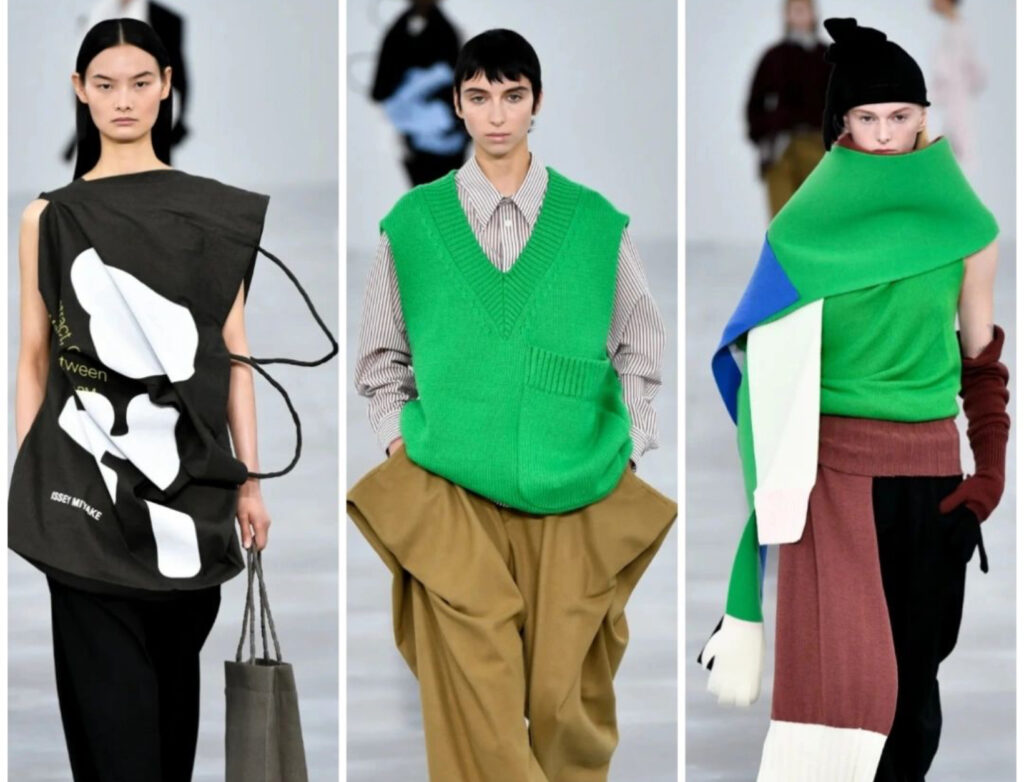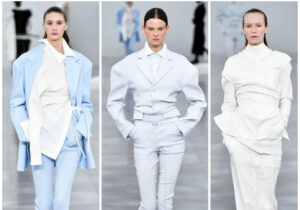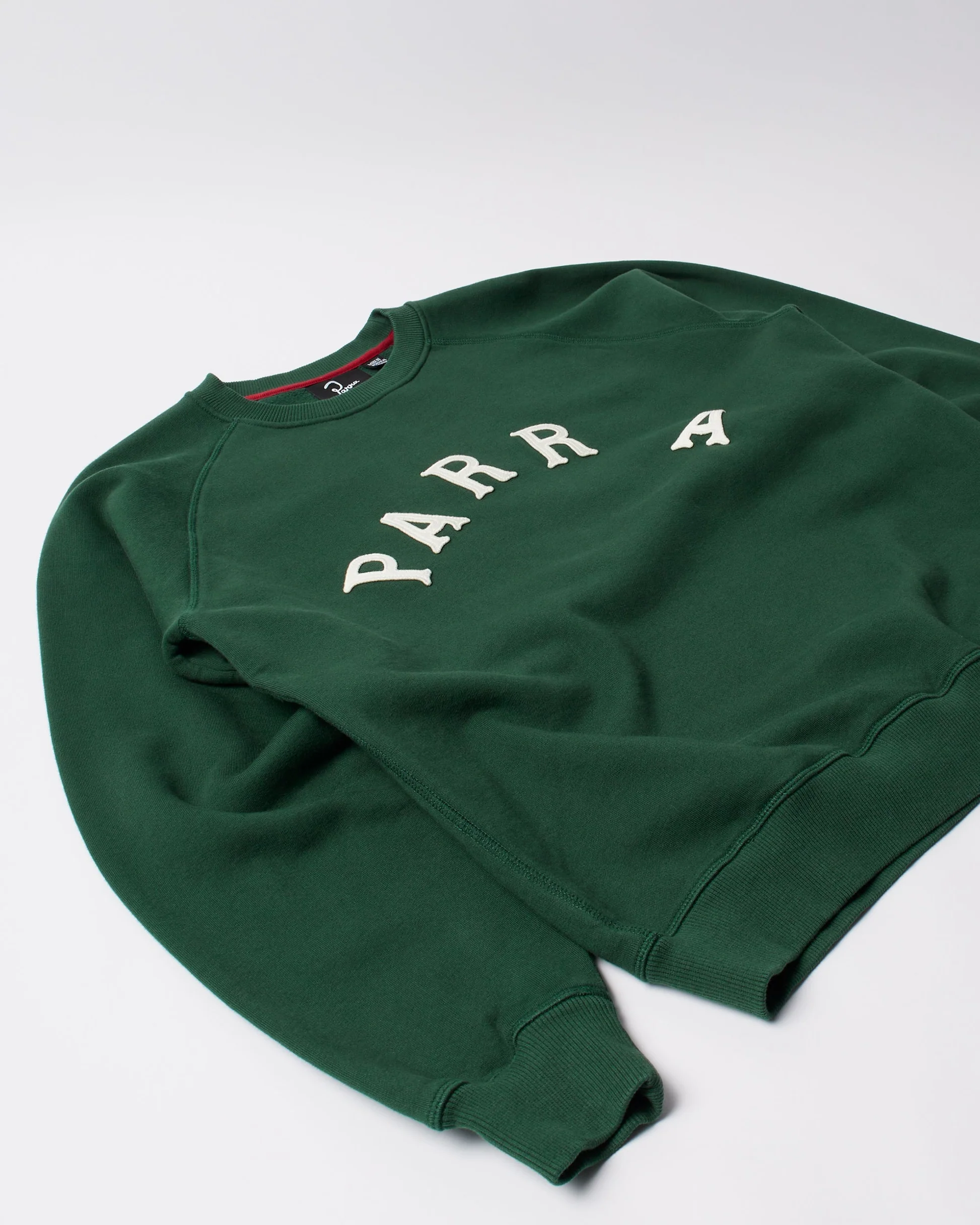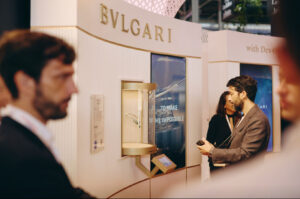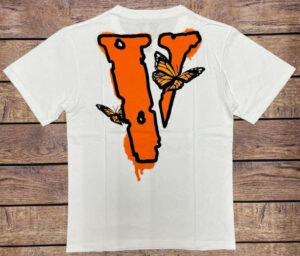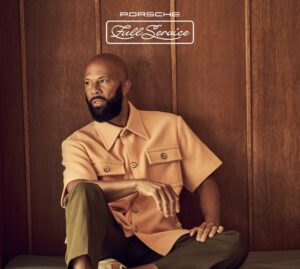At the intersection of abstraction and the concrete, sculpture and fashion, the Issey Miyake Fall 2025 collection emerged not just as a seasonal offering, but as a bold exercise in philosophical design. Under the thoughtful and experimental leadership of creative director Satoshi Kondo, the brand presented a collection that was less about linear storytelling and more about the shapeshifting beauty of ambiguity. It was a study in opposites—and in what exists in between them.
This season’s show, titled “[N]either [N]or,” served as both a runway presentation and an artistic meditation. The theme offered a conceptual roadmap for the viewer—an invitation to let go of definitions, fixed roles, and binary thinking. Instead, it asked us to dwell in that liminal space where form does not follow function, but becomes one with it. Is this a jacket or a sculpture? A dress or a structure? A garment or a moment of transformation?
As Kondo explained in a pre-show interview: “As a designer, I have always been drawn to what’s ambiguous, vague—not really defined. That’s something that you wouldn’t normally connect. By exploring the space in between all those binaries, the intention is to shed some light on that ambiguity and make the audience aware of what is abstract, what is concrete, and to make them rethink what a piece of garment is.”
A Sculptural Prelude: Erwin Wurm’s Influence
The show opened with a striking performance of one-minute sculptures inspired by Austrian artist Erwin Wurm, known for his surreal, often humorous reinterpretations of the mundane. Models wore garments as if they were part of a living art installation. Limbs twisted, torsos folded, shoulders stretched—each motion turning fabric into form, figure into art. These wearable sculptures blurred the line between object and body, redefining how clothing interacts with human motion.
Wurm’s influence wasn’t just stylistic—it was structural. The garments in these opening looks toyed with perception. Some pieces looked rigid, almost architectural, while others were soft and shifting, like fabric frozen in time mid-whirl. This performative prelude set the tone for what would unfold: a collection that challenges traditional notions of dressing, utility, and design.
The Ordinary Made Extraordinary
From there, the runway transitioned into wearable expressions of Kondo’s conceptual seed: garments created from the push and pull between visual illusion and practical wearability. Silhouettes were distorted, hybridized, and playfully reconfigured. Oversized jackets with broadened shoulders and dramatically cinched waists formed new body topographies. Asymmetrical coats featured collars that twisted and slouched in counterintuitive ways, creating movement even in stillness.
Prints played their own mind games. The first two looks featured prints of the third look—a sculptural red seamless dress combining different knit structures. In essence, the runway unfolded like a visual puzzle, where clothing became both the image and the original. This recursive idea—of something becoming itself—fit perfectly with the theme of “neither/nor,” where definitions are constantly upended.
Volumes and Dualities
Volume played a starring role this season. Jackets ballooned outward while the midsections narrowed dramatically. Dresses flowed in unexpected trajectories, with panels that looked like they might float off at any moment. Hems were uneven, shoulders over-exaggerated, and sleeves spilled far beyond the wrist.
Color was used purposefully, not flamboyantly. There was a base of neutral hues—ivories, grays, and blacks—but these were punctuated by flashes of deep red, mustard yellow, icy blue, and vibrant green. Often, colors were paired in unexpected combinations, accentuating the surreal contrast within the garments themselves.
Kondo’s construction methods also nodded to binary integrations: the juxtaposition of soft knitwear with rigid, sculptural elements, or the blending of organic fibers with synthetic, high-tech textiles. These dualities were never stark—they were married gracefully into one piece, forcing the viewer to question what is natural and what is fabricated.
Trompe-L’oeil and the Art of Deception
In keeping with the collection’s conceptual nature, Kondo and his team leaned into trompe-l’oeil effects. Several pieces posed as one thing while functioning as another: a shirt that resembled a bag, a cape that unraveled into a dress, or a scarf that turned out to be structural support for a larger silhouette. This illusionary tactic invited curiosity and demanded a second glance. Issey Miyake is no stranger to avant-garde technique, but here, the brand’s artistry felt more philosophical than ever.
Technological Textile Innovations
Issey Miyake’s legacy has long included textile innovation—and this season was no exception. In the final sequence of the show, the collection introduced pieces crafted with a blend of wool and alpaca yarn fused with thermoplastic synthetic fibers. Once heat-pressed, the garments developed a crisp, slightly shiny texture—something like wearable origami. These futuristic fabrics allowed for exaggerated folds, sculptural layering, and a metallic-like movement.
One standout was a green-and-white striped short dress paired with a matching wafting jacket that featured a dramatic hood. Despite the futuristic material, the ensemble exuded warmth and fluidity. It demonstrated that innovation does not mean sacrificing emotion—something that Kondo consistently achieves in his work.
Gender, Fluidity, and Identity
Issey Miyake has always maintained a flexible approach to gender, and Fall 2025 continued this ethos. The collection flowed seamlessly between menswear and womenswear, often blurring the distinction altogether. Many garments were unisex in both structure and styling, highlighting the house’s commitment to inclusivity and universality.
Tailoring was approached with a deconstructivist eye. Double-breasted coats were reimagined with displaced buttons and elongated proportions. Knits wrapped like shawls but functioned as structured tops. Utility met elegance, and tradition met subversion, creating looks that were open to interpretation rather than locked into a specific gender identity.
Movement as Design
No Issey Miyake collection is complete without a focus on movement. Fall 2025 featured flowing trousers, swirling sleeves, and coats that billowed with the choreography of each model. Motion wasn’t just accommodated—it was essential to the identity of the garments. Each piece came alive in motion, reminding us that the body is the final brushstroke in fashion design.
And, as always, the runway show felt more like a dance than a march. Models strode with intention, playfulness, and emotion. Garments interacted with the body and the air, proving that fashion—when done with vision—is not static. It breathes, it bends, and it transforms.
Kondo’s Quiet Radicalism
Satoshi Kondo’s work continues to evolve in subtle yet radical ways. He doesn’t shout. He doesn’t shock. Instead, he invites the viewer into a gentle interrogation of form and meaning. Fall 2025 felt like a natural extension of his personal design language: thoughtful, poetic, intelligent, and humane. Where many designers rush to follow trend cycles, Kondo digs inward, drawing from philosophy, art, and abstraction.
He respects the house’s heritage—its innovation, its pleats, its dedication to the interplay of clothing and the human form—but he brings to it a fresh clarity. Issey Miyake, under Kondo, is a space of play and questioning. A collection like “[N]either [N]or” doesn’t claim to have answers. It revels in the questions themselves.
Impression
Fall 2025 was not about selling products—it was about communicating ideas. It was about the undefined space between binary opposites, and how fashion, more than any other medium, can give form to that ambiguity. Kondo’s show was one of presence and poetry. It invited introspection but never lost its sense of joy. It was strange, sculptural, and smart, but also lighthearted and wearable.
In the fast-paced, often oversaturated world of fashion, Issey Miyake Fall 2025 offered a rare kind of depth. It reminded us that clothing doesn’t just cover the body—it communicates. It questions. It transforms.
And sometimes, it even sculpts.
No comments yet.

